CCRN
Latest uploads at CCRN. Looking for notes at CCRN? We have lots of notes, study guides and study notes available for your school.
-
1400
- 0
-
76
All courses for CCRN
-
CCRN 1394
-
CCRN , 1
-
CCRN 1
-
CCRN! 2
Latest notes & summaries CCRN
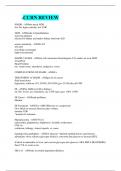
SIADH - ANStoo much ADH low Na, hypo-osmolar, low UOP ADH - ANSmade in hypothalamus stored in pituitary released to kidney and makes kidney hold onto h20 serum osmolarity - ANSNa X2 275-295 low=fluid overloaded high=concentrated SIADH CAUSES - ANSoat cell carcinoma (bronchogenic CA)-makes its own ADH Viral PNA Head Problem inc. serum osmo, anesthesia, analgesics, stress COMPLICATIONS OF SIADH - ANSSz's TREATMENT of SIADH - ANSget rid of causes fluid restrictions hypertonic solut...
- Exam (elaborations)
- • 16 pages's •
-
CCRN•CCRN
Preview 3 out of 16 pages
SIADH - ANStoo much ADH low Na, hypo-osmolar, low UOP ADH - ANSmade in hypothalamus stored in pituitary released to kidney and makes kidney hold onto h20 serum osmolarity - ANSNa X2 275-295 low=fluid overloaded high=concentrated SIADH CAUSES - ANSoat cell carcinoma (bronchogenic CA)-makes its own ADH Viral PNA Head Problem inc. serum osmo, anesthesia, analgesics, stress COMPLICATIONS OF SIADH - ANSSz's TREATMENT of SIADH - ANSget rid of causes fluid restrictions hypertonic solut...
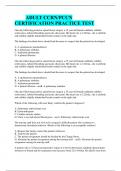
One day following posterior spinal fusion surgery a 35 year old female suddenly exhibits restlessness, labored breathing and acute chest pain. Her heart rate is 122/min., she is afebrile, and exhibits slightly diminished breath sounds on the right side. The findings described above should lead the nurse to suspect that the patient has developed: A. A spontaneous pneumothorax B. A pulmonary embolus C. Aspiration pneumonia D. A pleural effusion One day following posterior spinal fusion sur...
- Exam (elaborations)
- • 11 pages's •
-
CCRN•CCRN
Preview 2 out of 11 pages
One day following posterior spinal fusion surgery a 35 year old female suddenly exhibits restlessness, labored breathing and acute chest pain. Her heart rate is 122/min., she is afebrile, and exhibits slightly diminished breath sounds on the right side. The findings described above should lead the nurse to suspect that the patient has developed: A. A spontaneous pneumothorax B. A pulmonary embolus C. Aspiration pneumonia D. A pleural effusion One day following posterior spinal fusion sur...
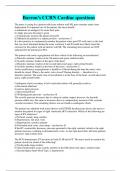
The nurse is caring for a patient with acute inferior wall MI, post-coronary artery stent deployment. For optimal care of the patient, the nurse should: a) administer an analgesic for acute back pain b) Apply pressure dressing to groin c) Continuously monitor the patient in lead II d) Maintain the patient in a supine position - ansAnswer: C It is best practice to continuously monitor the patient status post PCI with stent, in the lead that was most abnormal during the acute occlusion. Lea...
- Exam (elaborations)
- • 14 pages's •
-
CCRN•CCRN
Preview 2 out of 14 pages
The nurse is caring for a patient with acute inferior wall MI, post-coronary artery stent deployment. For optimal care of the patient, the nurse should: a) administer an analgesic for acute back pain b) Apply pressure dressing to groin c) Continuously monitor the patient in lead II d) Maintain the patient in a supine position - ansAnswer: C It is best practice to continuously monitor the patient status post PCI with stent, in the lead that was most abnormal during the acute occlusion. Lea...
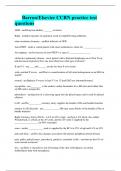
ADH - ansPhenytoin inhibits _______ secretion Right - ansMost episodes of aspiration result in (right/left) lung infiltrates. urine creatinine clearance - ansBest indicator of GFR Auto-PEEP - ansIn a vented patient with status asthmaticus, check for _______________ Air trapping - ansAn increase in auto-PEEP is a sign of _________________. obstructive pulmonary disease - ansA patient with a flattened diaphragm on a Chest X-ray and decreased expiratory flow rate most likely has what type of ...
- Exam (elaborations)
- • 19 pages's •
-
CCRN•CCRN
Preview 3 out of 19 pages
ADH - ansPhenytoin inhibits _______ secretion Right - ansMost episodes of aspiration result in (right/left) lung infiltrates. urine creatinine clearance - ansBest indicator of GFR Auto-PEEP - ansIn a vented patient with status asthmaticus, check for _______________ Air trapping - ansAn increase in auto-PEEP is a sign of _________________. obstructive pulmonary disease - ansA patient with a flattened diaphragm on a Chest X-ray and decreased expiratory flow rate most likely has what type of ...
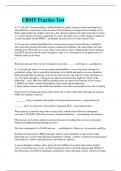
A 17 year old is demonstrating a sudden decline in grades, increased unexcused absences, and inability to concentrate when in school. Facial affect has changed from friendly to flat. When approached, the student states he is fine. Reports indicate the client responds to music, so a music therapy referral is requested. To assess possible causes of the change in behavior, a music therapist should FIRST - ansidentify current stressors in the student's life. A 52-year-old woman hospitalized fo...
- Exam (elaborations)
- • 11 pages's •
-
CCRN•CCRN
Preview 2 out of 11 pages
A 17 year old is demonstrating a sudden decline in grades, increased unexcused absences, and inability to concentrate when in school. Facial affect has changed from friendly to flat. When approached, the student states he is fine. Reports indicate the client responds to music, so a music therapy referral is requested. To assess possible causes of the change in behavior, a music therapist should FIRST - ansidentify current stressors in the student's life. A 52-year-old woman hospitalized fo...

cardiac output - ANSThe volume of blood ejected from the left side of the heart in one minute. 4-8 L/min HR x SV Cardiac Index - ANSCO/BSA 2.5-4.3 Stroke Volume (SV) - ANSThe amount of blood pumped out of the heart with each contraction. (Vol ejected with each beat) 60-100 Preload. Afterload Contractility Stoke Volume Index (SVI) - ANS35-60 Preload - ANSvolume of blood in ventricles at end of diastole Pressure generated by vol of blood in ventricle at end of diastole RV: cvp right...
- Exam (elaborations)
- • 3 pages's •
-
CCRN•CCRN
Preview 1 out of 3 pages
cardiac output - ANSThe volume of blood ejected from the left side of the heart in one minute. 4-8 L/min HR x SV Cardiac Index - ANSCO/BSA 2.5-4.3 Stroke Volume (SV) - ANSThe amount of blood pumped out of the heart with each contraction. (Vol ejected with each beat) 60-100 Preload. Afterload Contractility Stoke Volume Index (SVI) - ANS35-60 Preload - ANSvolume of blood in ventricles at end of diastole Pressure generated by vol of blood in ventricle at end of diastole RV: cvp right...
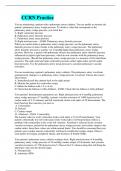
You are monitoring a patient with a pulmonary artery catheter. You are unable to measure the patient's pulmonary artery wedge pressure. To obtain a value that corresponds to the pulmonary artery wedge pressure, you check the: A. Right ventricular pressure B. Pulmonary artery diastolic pressure C. Pulmonary artery mean pressure D. Right atrial pressure - ANSB. Pulmonary artery diastolic pressure When you cannot obtain a pulmonary artery wedge pressure, use the pulmonary artery diastolic ...
- Exam (elaborations)
- • 4 pages's •
-
CCRN•CCRN
Preview 1 out of 4 pages
You are monitoring a patient with a pulmonary artery catheter. You are unable to measure the patient's pulmonary artery wedge pressure. To obtain a value that corresponds to the pulmonary artery wedge pressure, you check the: A. Right ventricular pressure B. Pulmonary artery diastolic pressure C. Pulmonary artery mean pressure D. Right atrial pressure - ANSB. Pulmonary artery diastolic pressure When you cannot obtain a pulmonary artery wedge pressure, use the pulmonary artery diastolic ...
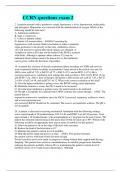
2. A patient presents with a productive cough, hypoxemia, a fever, hypotension, tachycardia, and tachypnea. Hypoxemia was corrected with the administration of oxygen. Which of the following should be done next? A. Administer antibiotics. B. Start a vasopressor. C. Collect a sputum culture. D. Initiate 0.9 normal saline. - ANS(D) Correcting the hypotension (with isotonic fluid resuscitation in order to maintain organ perfusion) is the priority at this time. Antibiotics (choice (A)) will ...
- Exam (elaborations)
- • 15 pages's •
-
CCRN•CCRN
Preview 2 out of 15 pages
2. A patient presents with a productive cough, hypoxemia, a fever, hypotension, tachycardia, and tachypnea. Hypoxemia was corrected with the administration of oxygen. Which of the following should be done next? A. Administer antibiotics. B. Start a vasopressor. C. Collect a sputum culture. D. Initiate 0.9 normal saline. - ANS(D) Correcting the hypotension (with isotonic fluid resuscitation in order to maintain organ perfusion) is the priority at this time. Antibiotics (choice (A)) will ...
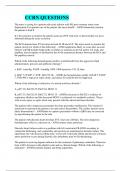
The nurse is caring for a patient with acute inferior wall MI, post-coronary artery stent deployment, For optimal care of the patient, the nurse should: - ANSContinuously monitor the patient in lead II It is best practice to monitor the patient status post PCI with stent, in the lead that was most abnormal during the acute occlusion. The ECG demonstrates ST elevation in leads II, III and aVF. The nurse needs to monitor the patient closely for which of the following? - ANSComplication likel...
- Exam (elaborations)
- • 20 pages's •
-
CCRN•CCRN
Preview 3 out of 20 pages
The nurse is caring for a patient with acute inferior wall MI, post-coronary artery stent deployment, For optimal care of the patient, the nurse should: - ANSContinuously monitor the patient in lead II It is best practice to monitor the patient status post PCI with stent, in the lead that was most abnormal during the acute occlusion. The ECG demonstrates ST elevation in leads II, III and aVF. The nurse needs to monitor the patient closely for which of the following? - ANSComplication likel...

Heart rate (HR) - ANS60-100 beats/min Mean arterial pressure (MAP) - ANS70-105 mmHg Cardiac output (CO) - ANS4-5 L/min Cardiac index (CI) - ANS2.5-4.5 L/min/m2 Stroke volume (SV) - ANS50-100 ml/beat Stroke index (SI) - ANS35-60 ml/m2/beat Right arterial pressure (RAP) - ANS4-8 mmHg Pulmonary artery pressure (PAP) - ANSSystolic 15-30 mmHg Diastolic 5-15 mmHg Pulmonary artery occlusive pressure (PAOP) - ANS8-12 mmHg Systemic vascular resistance (SVR) - ANS800-1200 dynes/sec/cm-5 Systemi...
- Exam (elaborations)
- • 8 pages's •
-
CCRN•CCRN
Preview 2 out of 8 pages
Heart rate (HR) - ANS60-100 beats/min Mean arterial pressure (MAP) - ANS70-105 mmHg Cardiac output (CO) - ANS4-5 L/min Cardiac index (CI) - ANS2.5-4.5 L/min/m2 Stroke volume (SV) - ANS50-100 ml/beat Stroke index (SI) - ANS35-60 ml/m2/beat Right arterial pressure (RAP) - ANS4-8 mmHg Pulmonary artery pressure (PAP) - ANSSystolic 15-30 mmHg Diastolic 5-15 mmHg Pulmonary artery occlusive pressure (PAOP) - ANS8-12 mmHg Systemic vascular resistance (SVR) - ANS800-1200 dynes/sec/cm-5 Systemi...
